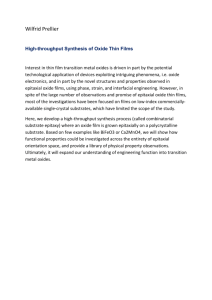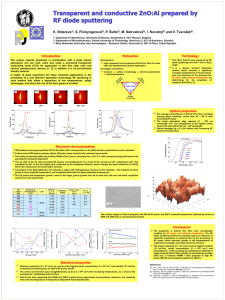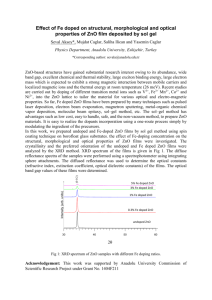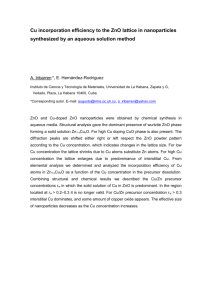Abstract - digital-csic Digital CSIC
advertisement
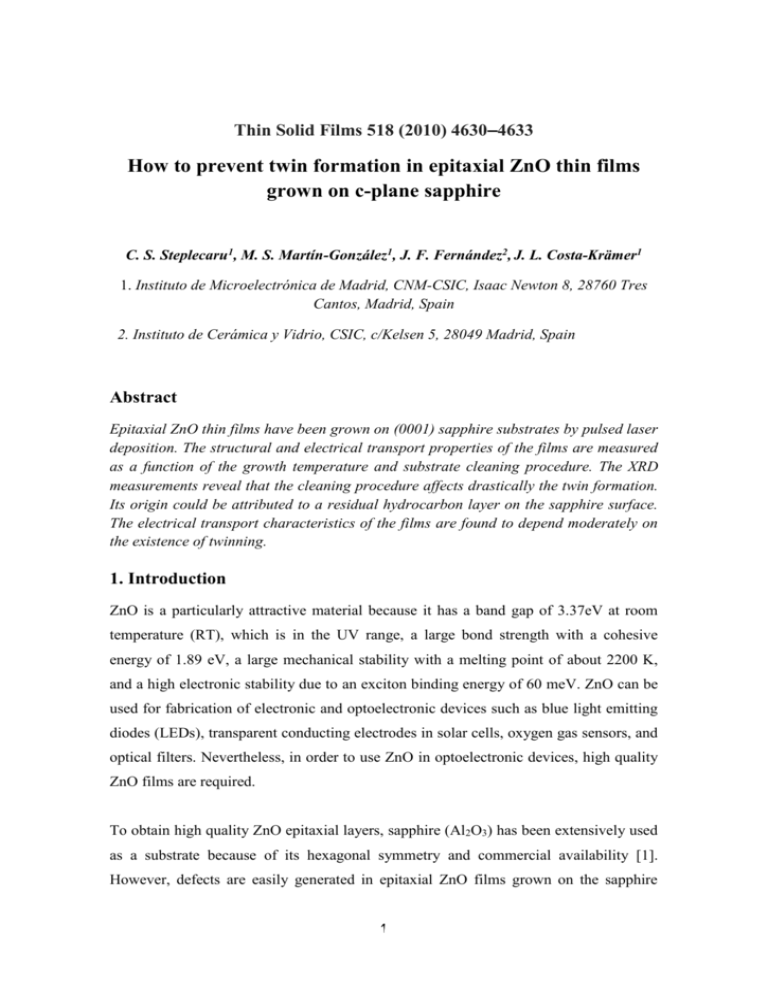
Thin Solid Films 518 (2010) 4630–4633
How to prevent twin formation in epitaxial ZnO thin films
grown on c-plane sapphire
C. S. Steplecaru1, M. S. Martín-González1, J. F. Fernández2, J. L. Costa-Krämer1
1. Instituto de Microelectrónica de Madrid, CNM-CSIC, Isaac Newton 8, 28760 Tres
Cantos, Madrid, Spain
2. Instituto de Cerámica y Vidrio, CSIC, c/Kelsen 5, 28049 Madrid, Spain
Abstract
Epitaxial ZnO thin films have been grown on (0001) sapphire substrates by pulsed laser
deposition. The structural and electrical transport properties of the films are measured
as a function of the growth temperature and substrate cleaning procedure. The XRD
measurements reveal that the cleaning procedure affects drastically the twin formation.
Its origin could be attributed to a residual hydrocarbon layer on the sapphire surface.
The electrical transport characteristics of the films are found to depend moderately on
the existence of twinning.
1. Introduction
ZnO is a particularly attractive material because it has a band gap of 3.37eV at room
temperature (RT), which is in the UV range, a large bond strength with a cohesive
energy of 1.89 eV, a large mechanical stability with a melting point of about 2200 K,
and a high electronic stability due to an exciton binding energy of 60 meV. ZnO can be
used for fabrication of electronic and optoelectronic devices such as blue light emitting
diodes (LEDs), transparent conducting electrodes in solar cells, oxygen gas sensors, and
optical filters. Nevertheless, in order to use ZnO in optoelectronic devices, high quality
ZnO films are required.
To obtain high quality ZnO epitaxial layers, sapphire (Al2O3) has been extensively used
as a substrate because of its hexagonal symmetry and commercial availability [1].
However, defects are easily generated in epitaxial ZnO films grown on the sapphire
1
substrate due to the large lattice mismatch of 18% or 32%, which depends on
crystallographic orientation relationships [2].
Most common defects due to the lattice mismatch are misfit dislocations, which have
been studied in detail [3-5], and twin domains which are less understood [4]. The
electrical properties of ZnO films are affected by film quality, orientation and interface
quality, as expected.
The twin formation in ZnO/Al2O3 (0001) films has been investigated only by a few
groups using growth techniques such as laser molecular beam epitaxy [2], metalorganic
chemical vapor deposition [6,7], Pulsed Laser Deposition (PLD) [8], and sputtering [9].
In all these cases, the twinning exhibits the following similarities: a) upon increasing the
growth temperature the twinning tends to disappear, b) the relative intensity of the
domains change from sample to sample when grown at the same conditions and c) the
appearance and the intensity of the twinning maxima depends on the deposition rate.
Different theories have been developed to explain the twinning effect in ZnO films.
According to Ohkubo et al., the preferential growth of the 300 twisted domains at low
temperature is due to kinetic factors. The aligned in-plane oriented (main) domains are
thermodynamically more stable than the 300 rotated domains [2]. The improvement of
the film alignment has been correlated with the increase of surface mobility of the
adatoms at large growth temperatures [8]. Kim et al. performed a study of the twin
formation mechanism of sputter-grown epitaxial ZnO/Al2O3(001) films, correlating it
with the strain evolution. Their study revealed that the twin in the sputter-grown ZnO
thin films is a mechanical twin, not a growth twin (indicated by the existence of a
transition thickness at which the twin domains nucleate followed by the gradual strain
relaxation) [9].
In this study, the PLD technique has been used since it is a suitable method for growing
thin oxide films. This is so because of its ability to control oxygen gas pressure in a
wide range, thus obtaining oxide films with a good crystalline structure and a preferred
c-axis orientation [8]. The twin formation origin of epitaxial ZnO films deposited on
(0001) Al2O3 substrates by PLD technique is described. Twinning is shown to be
affected by the substrate cleaning procedure, and their influence on structural and
2
electrical properties of films obtained under the same conditions, but different cleaning
procedures, are presented.
2.
Experimental details
The deposition of the ZnO films was carried out in a homemade PLD deposition
chamber, using an ArF Excimer laser (Lambda Physics Lasertechnik LPX 205i MC)
operating at 193nm in order to ablate the ZnO target. ZnO films were deposited on
(0001) sapphire substrates. The excimer laser pulse energy was set at 200mJ per pulse,
repetition rate of 10 Hz and pulse duration of 17 ns. The laser beam was focused on the
rotating target into a spot size of 1mm diameter. The distance between the target and the
substrate was 2.5cm. The target was made from high purity ZnO powders sintered at
1300˚C for 8 hours. The deposition chamber was first evacuated by a pump-system
(turbo and rotary pumps) to 1x10-5 mbar, and then high purity oxygen was introduced
through a mass flow controller and maintained at the desired pressure (~1.2x10-2 mbar)
during the deposition. The sample holder was a heater itself, where the temperature was
controlled by the current intensity applied and held constant during the deposition. The
temperature was measured by a calibrated thermocouple. The post growth cooling down
to room temperature procedure of the ZnO films was made maintaining the same
oxygen pressure.
The ZnO films were deposited on (0001) sapphire substrates at growth temperatures
ranging from room temperature (RT) to 600oC. Furthermore, another set of films was
prepared in the same range of temperature, where the substrates were cleaned by a
different procedure. For both set of films, in order to remove dust and surface
contamination of the substrates, the (0001) sapphire wafers were prepared by ultrasonic
cleaning, first in acetone for 10 minutes and then in isopropanol for 10 minutes, and
finally blown dried with high purity nitrogen gas. For the second cleaning procedure the
substrates were additionally immersed in oxygen plasma cleaning at 200 W for 5
minutes.
The structural properties of the grown films were characterized by X-Ray diffraction
(XRD) measurements, carried out using a Philips X´Pert four-circle diffractometer
system with CuKα radiation.
3
The electrical properties of the films were determined by Hall Effect measurements,
using van der Pauw configuration. For the van der Pauw four-probe geometry metallic
contacts were deposited on top of the films, in the sequence Ti/Al/Pt/Au, each one
having a thickness of 150 Ǻ. [10,11] Afterwards they were annealed at 150oC for 20
minutes. Before measuring the temperature dependence of the transport properties, the
ohmic character of the contacts was verified. Measurements of the electrical resistivity,
carrier density and Hall mobility were performed from 33 to 300K.
3. Results and discussion
Influence of growth Temperature
XRD 2Ө/ω scans measurements for the ZnO films were made (not shown here), in
order to analyze the out-of-plane orientation of the films. All the films presented only
{000l} diffraction maxima which indicated that the c-axis growths perpendicular to the
substrate plane.
The coherence length of the films as a function of the growth temperature as calculated
from the Scherrer formula using the full-width at half maximum (FWHM) of ZnO
(0002) maxima of the 2θ/ω scan as input is shown in Fig. 1. When plotting the
coherence length vs. substrate temperature, two regimes can be observed for the
samples where no extra oxygen plasma cleaning was used. This type of behavior is
characteristic of two-domain films. It is attributed to the activation of a new adatom
surface diffusion process at Ts >200 °C that became dominant at Ts>500ºC.
The epitaxial relationship between ZnO and the sapphire/Al2O3 substrates was
determined by asymmetrical XRD measurements. Fig. 2 displays the in-plane Φ scans
for the (1013) plane of the ZnO films and for the (1123) plane of the sapphire substrate.
As it can be seen, the epitaxial relationship started at 200°C. The sample grown at
200°C presented 6 peaks separated by 60˚, characteristic of the six-fold symmetry.
These peaks were rotated 30oC with respect to the substrate, thus confirming the
epitaxial relationship [1120]ZnO||[1120]sapphire. The sample grown at 400˚C exhibited 12
peaks, which indicated the coexistence of 2 domains: a main domain aligned with the
sapphire substrate, and a so-called “twin” domain which was rotated 30o with respect to
the main one. The low intensity of the peaks and the relatively high background signal
4
were indicative of both poor in-plane orientation and high contribution of the crystallites
with random in-plane orientation. When increasing the growth temperature, the twin
peaks intensity decreased and disappeared for the samples grown at 600oC, which
presented just a main domain aligned with the substrate [1010]ZnO||[1120]sapphire.
Influence of substrate cleaning
To elucidate the impact of twinning in electrical properties a second set of films were
prepared with an extra oxygen plasma cleaning step before deposition. There were
indications that the quality of the oxide-oxide interfaces (roughness, interdiffusion) was
critical for the final performance.
It is, therefore, of great importance to understand the
basic principles governing the oxide-on-oxide growth, which still remains a largely
unexplored subject.
XRD 2Ө/ω scans measurements for the substrates cleaned with and without oxygen
plasma presents the same diffraction pattern. The corresponding ZnO films deposited on
top of these substrates exhibit the same {000l} diffraction maxima (not shown here).
Regarding the coherence length of the films as a function of the growth temperature, it
can be seen that the samples cleaned with oxygen plasma exhibit an almost linear
relationship (see Fig. 1).
The epitaxial relationship between ZnO and the sapphire/Al2O3 substrates was also
determined by asymmetrical XRD measurements. For the samples cleaned by oxygen
plasma the epitaxial relationship started as low as RT (not shown here), which is lower
compared to the temperature of 200°C for the samples cleaned without oxygen plasma.
To the best of our knowledge RT is the lowest growth temperature at which epitaxial
films have been obtained.
Fig. 3 shows the in-plane Φ scans for the (1013) plane of the ZnO films grown at
400°C, with and without oxygen plasma cleaning procedure. The sample that has been
exposed to oxygen plasma cleaning before the deposition were free of twin domains,
although it has been grown under the same growth conditions. The deposition onto
5
oxygen plasma pretreated substrates always resulted in films whose Φ -scans show only
six strong peaks separated by 60°. This fact clearly indicated a single-domain in-plane
orientation around the c-axis, with the a-axis aligned with respect to the substrate.
The origin of the 30º rotation could be attributed to residual hydrocarbons layer (C-HO) on the sapphire surface because of the chemical cleaning procedure (see
experimental section), since by the elimination of this layer during the plasma cleaning
procedure the formation of twin domains was avoided. The appearance of a new adatom
surface diffusion process detected at TS >300 °C (see figure 1) could be related to the
temperature at which the hydrocarbons layer started to desorbs from the sapphire
surface in vacuum. This hydrocarbon layer was completely eliminated when heating the
substrate at temperature >500ºC in vacuum conditions.
At 300 and 400ºC the
desorption of the hydrocarbon layer was inhomogeneous, therefore the aligned domain
appeared where the hydrocarbon layer was removed, while the rotated domain
originated where the hydrocarbon layer was still present when ZnO film started to grow.
This fact was confirmed by the variation of the domains intensity between different
series of samples.
On the other hand, in a previous study of ZnO grown on sapphire by atomic layer
epitaxy it was concluded that cleaning of sapphire with oxygen plasma increased the
density of hydroxyl group on the substrate surface [12]. Different density of hydroxyl
groups will produce a different concentration of reactive surface sites, therefore
increasing the nucleation rate of the film.
Fig. 4 shows an example of rocking-curves corresponding to the (0002)-ZnO reflection
for the samples grown at 400°C, but cleaned by different procedure. The FWHM value
of the XRD rocking curves was similar same for both samples, indicating that the
cleaning procedure did not affect the film quality along the [0001] direction.
Measurements of the electrical resistivity, carrier density and Hall mobility have been
also performed. As an example of such a measurement figure 5 (a-c) shows the behavior
of the electrical resistivity, carrier density and Hall mobility versus temperature, in the
range 33-300K, for films grown at 400oC. Table I shows the values of these electrical
properties at room temperature for the ZnO films prepared by both cleaning procedures.
6
It can be seen that the electrical transport characteristics of the films are not very
influenced by twinning. Both samples present n-type conductivity and have almost the
same resistivity; the only significant difference was the higher mobility values of the
sample un-exposed to the oxygen plasma cleaning.
4.
Conclusions
Epitaxial ZnO films have been grown on (0001) sapphire substrates using the PLD
technique. Two different substrate cleaning procedures have been demonstrated to
affect drastically the twin formation. Cleaning the substrate by oxygen plasma after a
conventional organic solvent cleaning procedure is demonstrated to eliminate the
appearance of the twin domains. The origin of the twin domains has been tentatively
correlated with the existence of the residual hydrocarbons on the substrate surface prior
to the PLD growth, although the twinning did not affect the grain size. Electrical
transport measurements of the films show that there is no significant influence due to
the existence of twinning.
Acknowledgments
This work was financially supported by CYCYT MAT2007-66845-C02-01, CSIC
2006-50F0122, CSIC 2007-50I015 and MAT2008-06330. We also thank to Raquel
Álvaro and Mariana Köber for cooperation.
References
[1] F. Vigué, P. Vennéguès, C. Deparis, S. Vézian, M. Laügt, J.-P. Faurie, J. Appl.
Phys. 90 (2001) 5115
[2] I. Ohkubo, A. Ohtomo, T. Ohnishi, Y. Matsumoto, H. Koinuma and M. Kawasaki,
Surf. Sci. 443 (1999) L1043
[3] D.M. Hwang, S.A. Schwarz, T.S. Ravi, R. Bhat, C.Y. Chen, Phys. Rev. Lett. 66
(1991) 739
[4] J. Narayan, K. Dovidenko, A.K. Sharma, S. Oktyabrsky, J. Appl. Phys. 84 (1998)
2597
[5] W.-Y. S, C.-Y. C, S.-C. Chin, C.-F. Huang, T.-Y. Tang, Y.-C. Lu, Y.-L. Lin, L.
Hong, F.-Y. Jen, C.C. Yang, B.-P. Zhang, Y. Segawa, J. Appl. Phys. 99 (2006) 054301
[6] S.-H. Park, S.-Y. Seo, S.-H. Kim, S.-W. Han, Appl. Phys. Lett. 88 (2006) 251903.
7
[7] B. Zhang, L. Manh, K. Wakatsuki, K. Tamura, T. Ohnishi, M. Lippmaa, N. Usami,
M. Kawasaki, H. Koinuma and Y. Segawa, Jpn. J. Appl. Phys. Part 2 42 (2003) L264
[8] R.D. Vispute, V. Talyansky, Z. Trajanovic, S. Choopun, M. Downes, R.P. Sharma,
T. Venkatesan, M.C. Woods, R.T. Lareau, K.A. Jones, A.A. Iliadis, Appl. Phys. Lett. 70
(1997) 2735
[9] I.-W. Kim, K.-M. Lee, Thin Solid Films 516 (2008) 4921
[10] S. J. Pearton, D. P. Norton, K. Ip, Y. W. Heo, T. Steiner, Progress in Mat. Sci., 50,
293 (2005)
[11] E. López-Ponce, J. L. Costa-Krämer, M. S. Martín-González, F. Briones,J. F.
Fernández, A. C. Caballero, M. Villegas, and J. de Frutos, Phys. Stat. Sol. (a) 203, 6,
1383 (2006)
[12] Jongmin Lim, Kyoungchul Shin, Hyounwoo Kim and Chongmu Lee, Thin Solid
Films 475 (2005) 256
Table caption
Table I. Electrical properties (resistivity, carrier density and mobility) measured at RT
for films grown at the same temperature of 400ºC, but prepared by different cleaning
procedure: with and without oxygen plasma.
T (ºC)
400
400
Cleaning
procedure
Resistivity
Carrier density
Mobility
(Ω cm)
(cm-3)
(cm2V-1s-1)
With
Oxygen
plasma
10x10-3
3x1019
12
Without
oxygen
plasma
15x10-3
n-type
1.2x1019
n-type
8
30
Figure caption
Figure 1. Crystalline coherence length for films grown at different temperatures.
Figure 2. In-plane Φ scans for the (1013) plane for the ZnO films grown at 200, 400
and 600ºC and for the (1123) plane of the sapphire substrate for the samples prepared
without oxygen plasma.
Figure 3. In-plane Φ scans for the (1013) plane of the ZnO films grown at 400oC on
substrates cleaned by 2 different procedures (with and without oxygen plasma).
Figure 4. Rocking-curves corresponding to the (0002)-ZnO reflection for films
deposited at the same grown temperature of 400oC, but cleaned by 2 different
procedures. The FWHM value of the XRD rocking curves are 0.10 and 0.11,
respectively.
Figure 5. Measurements of electrical properties for films grown at 400oC on substrates
cleaned by 2 different procedures (a) resistivity versus temperature; (b) carrier density
versus temperature; (c) mobility versus temperature
9
Figures:
75
65
60
55
50
Without plasma cleaning
With plasma cleaning
45
40
0
100
200
300
400
500
600
Growth Temperature (C)
Figure 1
ZnO(103)
Ts
o
600 C
Intensity (arb. units)
Coherence lenght (nm)
70
ZnO(103)
o
400 C
ZnO
(103)
o
200 C
Al2O3
(113)
0
60
120
180
(degrees)
Figure 2
10
240
300
360
Intensity (arb. units)
cleaned with O2plasma
cleaned without O2plasma
0
60
120
180
240
300
360
(degrees)
Figure 3
ZnO cleaned with O2 plasma FWHM=0.10
0
0
Intensity (arb. units)
ZnO cleaned without O2 plasma FWHM=0.11
17,0
17,2
17,4
(degrees)
Figure 4
11
17,6
without O2 plasma
0.030
with O2 plasma
(.cm)
0.025
0.020
0.015
0.010
0
50
100
150
200
250
300
350
Temperature (K)
(5a)
with O2 plasma
1,20E+020
without O2 plasma
8,00E+019
6,00E+019
4,00E+019
2,00E+019
0,00E+000
0
50
100
150
200
250
300
350
250
300
350
Temperature (K)
(5b)
without O2 plasma
30
with O2 plasma
25
20
2
-1 -1
Mobility (cm V s )
-3
Carrier density (cm )
1,00E+020
15
10
5
0
50
100
150
200
Temperature (K)
(5c)
Figure 5
12

